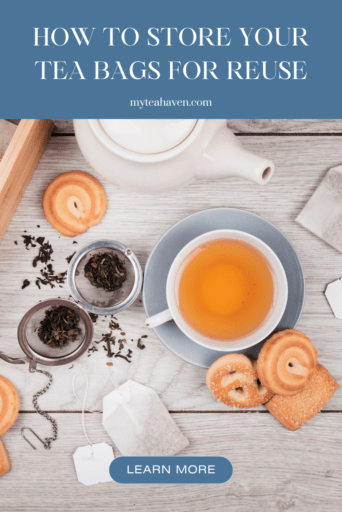Tea Time Reinvented: The Ultimate Guide to Storing Tea Bags for Reuse
How to Store Tea Bags for Reuse
Tea, a beverage cherished for centuries, has more to offer than just a delightful sip. With environmental concerns on the rise, the practice of reusing tea bags has gained significance. Beyond being a sustainable choice, it also adds a touch of frugality to our daily tea rituals. Join me on this journey as we explore how to store tea bags for reuse and unlock the secrets to a more sustainable tea-drinking experience.
We are a participant in the Amazon Services LLC Associates Program, an affiliate advertising program designed to provide a means for us to earn fees by linking to Amazon.com and related sites. This post may contain affiliate links which means we may receive a commission, at no cost to you, for purchases made using our links. Please see my disclosure to learn more. Unless otherwise stated, all prices are in US$.
Why Reuse Tea Bags?
Environmental Impact
Tea bags, when discarded after a single use, contribute significantly to our environmental woes. The paper, often thought to be biodegradable, might contain elements that hinder decomposition. By reusing tea bags, we can substantially reduce the amount of waste generated and play a small part in environmental conservation.
Economic Benefits
Apart from environmental considerations, reusing tea bags also makes economic sense. Quality tea can be a bit pricey, and getting a second infusion from your tea bags ensures that you get the most value out of every purchase. It’s a win-win situation for both your wallet and the planet.
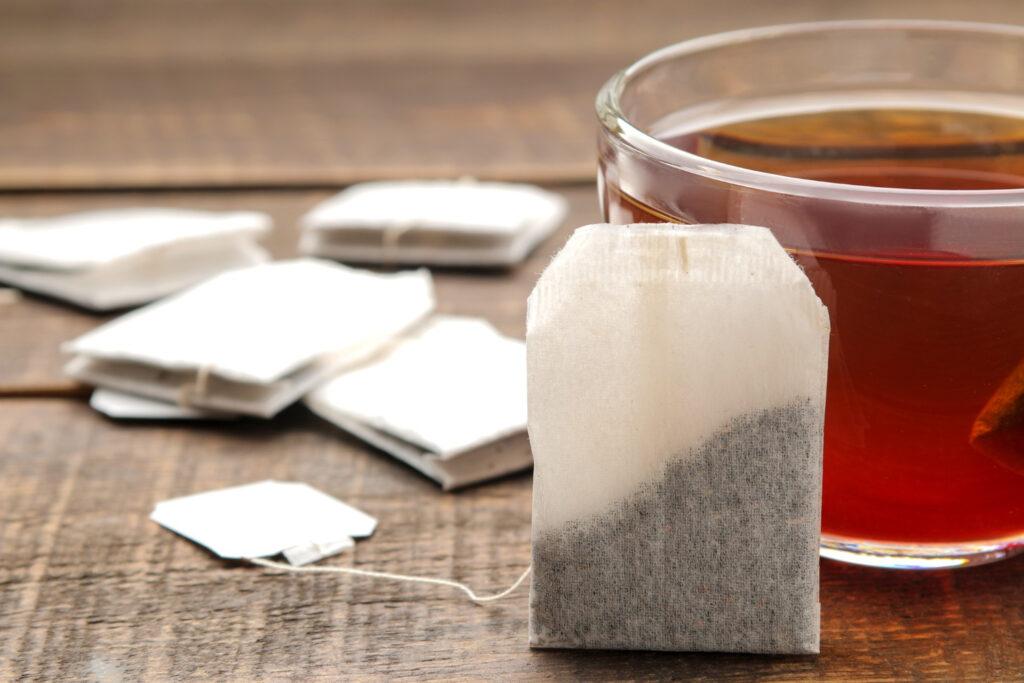
Choosing the Right Tea Bags
To embark on the journey of tea bag reuse, it’s crucial to start with the right tea bags. Look for high-quality options that can withstand multiple brews without compromising flavor. Avoid bags with staples or excessive glue, as these can affect the taste and safety of your tea.

Tinkee, Tea Filter Bags
The tea filter bag is made of Natural wood pulp filter paper. They are fully biodegradable and environmental friendly. The filter paper features strong penetration and high temperature resistant, let the tea seep through easily and quickly to get more strong tea.
Quality Considerations
Investing in loose-leaf teas or premium, unbleached tea bags ensures a better experience when it comes to reuse. These options often provide a cleaner and more vibrant flavor over multiple infusions.
Factors to Avoid
While selecting tea bags, steer clear of those with synthetic materials or excessive packaging. These can introduce unwanted flavors and diminish the joy of reusing your tea bags.
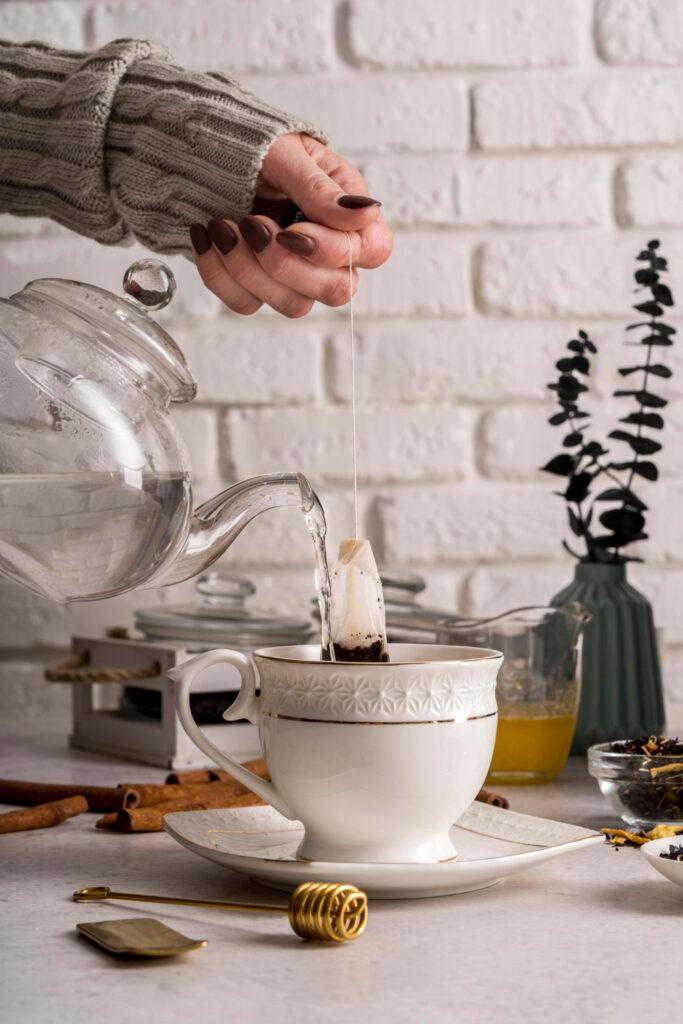
Proper Brewing for Reuse
The foundation of successful tea bag reuse lies in the initial brewing process. Pay attention to these quick tips to enhance the reusability of your tea bags.
Brewing for Longevity
Brew your tea slightly stronger than usual for the first infusion. This ensures that the flavors remain robust through subsequent uses, preventing a diluted taste.
Importance of Proper Brewing
Proper brewing not only enhances the taste of your first cup but also sets the stage for successful tea bag storage. By following these brewing tips, you’re laying the groundwork for a more extended tea bag lifespan.
Best Storage Practices
Once you’ve enjoyed your first cup, it’s time to focus on storing the tea bags properly. The way you store them can significantly impact the flavor and freshness of your next brew.
Factors Affecting Storage
Consider the environmental conditions in your storage area. Exposure to light, air, and moisture can degrade the quality of your tea bags over time. Choose a cool, dark place to maximize shelf life.
Role of Proper Storage
Proper storage is the key to preserving the delicate flavors of your tea. By understanding the factors that influence tea bag storage, you can ensure that each cup is as delightful as the last.
Avoiding Common Mistakes
In the quest for the perfect cup of reused tea, many people inadvertently make mistakes in the storage process. Let’s address these common errors and provide solutions for a flawless tea bag reuse experience.

Common Errors
- Forgetting to Seal Bags: Leaving tea bags exposed to air can lead to staleness.
- Storing Near Strong Odors: Tea easily absorbs surrounding odors, affecting its flavor.
- Ignoring Moisture Levels: Excess moisture can promote mold growth in stored tea bags.
Solutions
- Use Airtight Containers: Seal tea bags in airtight containers to prevent exposure to air.
- Isolate from Strong Smells: Store tea away from strong-smelling items to maintain its natural aroma.
- Use Desiccants: Consider adding desiccants to absorb excess moisture in storage containers.
Types of Tea Storage Containers
Exploring different containers for tea bag storage opens up a world of options. Each type comes with its own set of advantages and considerations.
Plastic Containers
- Pros: Lightweight, inexpensive, and readily available.
- Cons: May absorb odors and degrade over time.
Glass Jars
- Pros: Transparent, allowing you to see the contents. Resistant to odors.
- Cons: Risk of breakage, especially in busy kitchens.
Ceramic Canisters
- Pros: Provide a stylish and decorative storage option.
- Cons: Heavy and may chip or break if mishandled.
Metal Tins
- Pros: Durable, with a classic and functional design.
- Cons: May not be airtight, leading to potential flavor loss.

Dahlia Porcelain Airtight Tea Canister

Airscape Glass Food Storage Canister

Yesland Airtight 6 Pack Tea Tin Canisters
DIY Tea Storage Solutions
For those who enjoy a touch of creativity, here are some DIY solutions for storing tea bags sustainably.
Mason Jar Tea Organizer
- Gather empty mason jars.
- Decorate the lids for a personalized touch.
- Label each jar with the tea type inside.
Repurposed Tin Canisters
- Collect and clean tin canisters.
- Paint or decorate them to match your kitchen aesthetic.
- Stack the canisters for an organized display.
Upcycled Wooden Boxes
- Find old wooden boxes or crates.
- Sand and paint them in your preferred colors.
- Line with parchment paper for a rustic, eco-friendly storage solution.
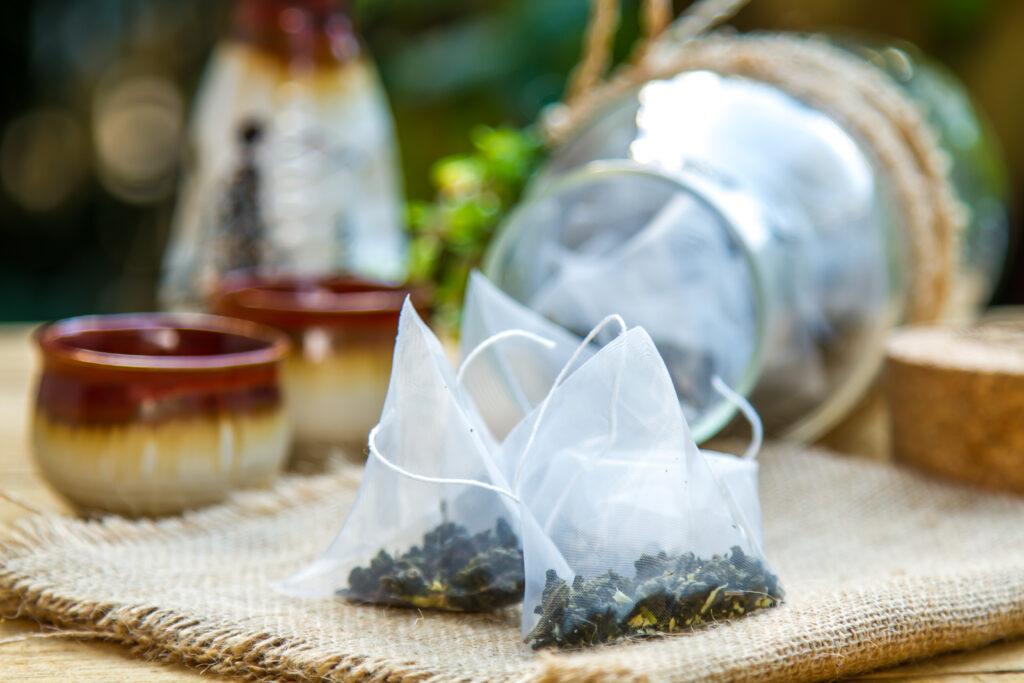
How Long Can You Store Tea Bags?
While tea bags won’t last indefinitely, proper storage can extend their lifespan. Factors such as tea type, storage conditions, and initial quality play a role in determining how long you can store your tea bags.
Shelf Life of Tea Bags
On average, well-stored tea bags can maintain their quality for six months to a year. Herbal and black teas tend to have a longer shelf life compared to more delicate green or white teas.
Influencing Longevity
- Tea Type: Some teas naturally have a longer shelf life.
- Storage Conditions: A cool, dark place with low humidity is ideal.
- Initial Quality: High-quality teas often retain their flavor for a more extended period.
Reviving Stale Tea Bags
If you find yourself with tea bags that have lost their luster, fear not. There are ways to breathe new life into stale tea bags.
Refreshing Techniques
- Citrus Infusion: Add a hint of citrus zest to revive flavors.
- Double Brewing: Brew two bags together for a stronger infusion.
- Spice Infusion: Experiment with spices like cinnamon or ginger for added depth.
Making Stale Tea Bags Taste Better
By employing these simple techniques, you can salvage tea bags that may have lost some of their original vibrancy. It’s a sustainable way to ensure that no tea bag goes to waste.
Tea Bag Storage for Different Types of Tea
Different types of tea require slightly varied storage approaches to maintain their distinct flavors. Let’s delve into considerations for herbal, green, black, and specialty teas.
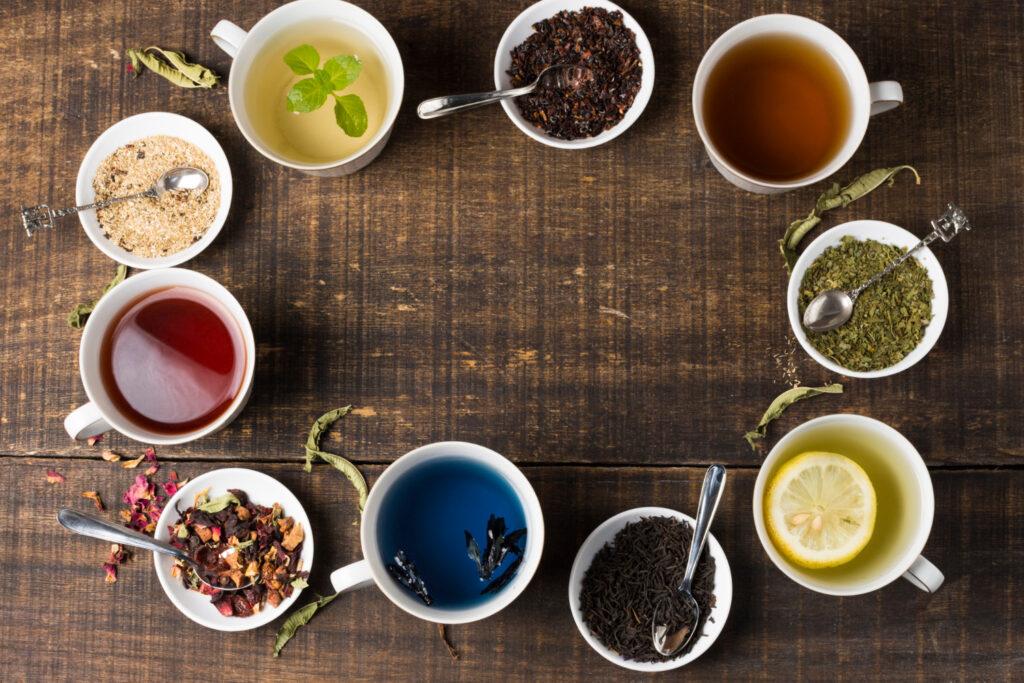
Herbal Teas
- Store in Dark Containers: Protect herbal teas from light to preserve their delicate flavors.
- Avoid Strong Odors: Herbal teas can easily absorb surrounding scents.
Green Teas
- Cool, Dark Storage: Green tea is sensitive to light and heat, so store in a cool, dark place.
- Avoid Airtight Containers: Allow some airflow to prevent moisture buildup.
Black Teas
- Airtight Containers: Black teas benefit from airtight containers to preserve their bold flavors.
- Dry Storage Area: Ensure the storage area is dry to prevent mold.
Specialty Teas
- Follow Specific Instructions: Some specialty teas may come with specific storage recommendations.
- Experiment with Flavors: Get creative with storage to enhance the unique characteristics of specialty teas.
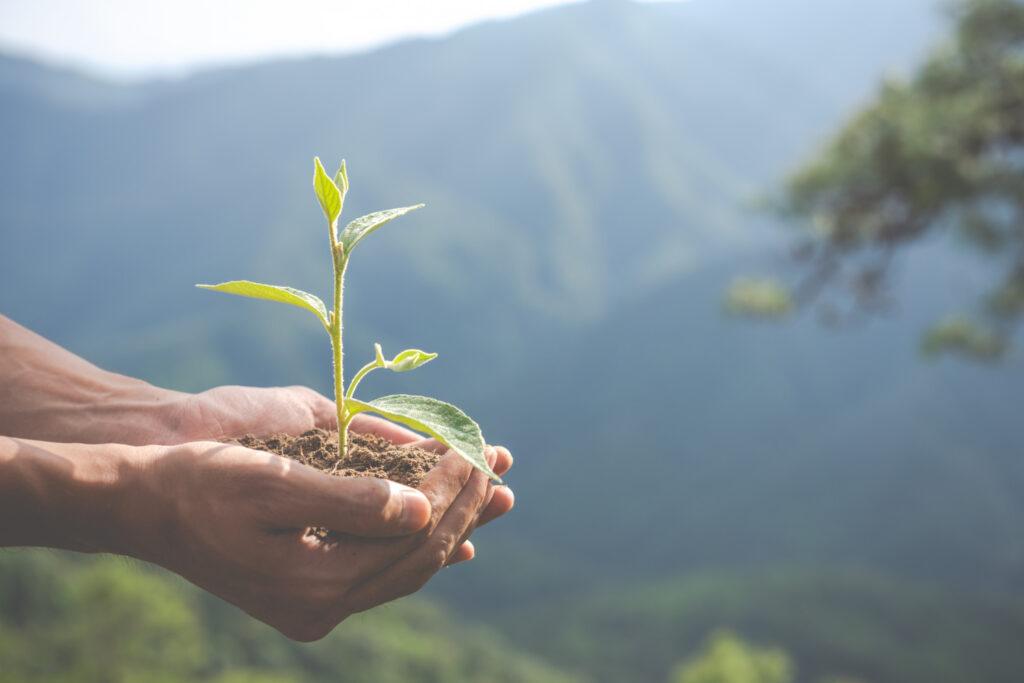
Sustainability and Tea Bag Reuse
The act of reusing tea bags extends beyond personal benefit; it’s a step towards sustainable living. As we minimize waste, we contribute to a healthier planet. Embrace the journey of reusing tea bags not only for the economic and flavor benefits but also as a conscious choice for a greener lifestyle.
Tea Bag Reuse and Health Considerations
While reusing tea bags is generally safe, there are a few health considerations to keep in mind.
Safety Guidelines
- Avoid Moldy Bags: Discard tea bags that show signs of mold.
- Maintain Clean Containers: Regularly clean storage containers to prevent contamination.
- Moderation is Key: Reuse tea bags within a reasonable timeframe to avoid potential health risks.
A Few Final Thoughts
In the pursuit of a sustainable and flavorful tea-drinking experience, the art of reusing tea bags takes center stage. From selecting the right tea bags to implementing proper storage techniques, every step contributes to a more eco-friendly and cost-effective tea ritual. Embrace the journey of tea bag reuse, not only for the joy it brings to your cup but for the positive impact it has on our planet. Cheers to a greener, more flavorful tea time!
Some Questions You Might Have
- Can I reuse any type of tea bag?
Absolutely! However, choosing high-quality tea bags with no staples or excessive glue enhances the reusability experience.
- How many times can I reuse a tea bag?
The number of reuses depends on factors like tea type and initial quality. On average, expect 2-3 uses for most tea bags.
- Can I store different tea bags together?
While it’s possible, it’s best to store similar types of tea together to prevent flavor transfer.
- Are there any teas that shouldn’t be reused?
Delicate teas like white tea are more challenging to reuse due to their subtle flavors. Focus on heartier teas for multiple uses.
- Is it safe to reuse tea bags?
Absolutely, as long as you follow proper storage and brewing practices. Avoiding mold and maintaining cleanliness is key to a safe tea bag reuse experience.

